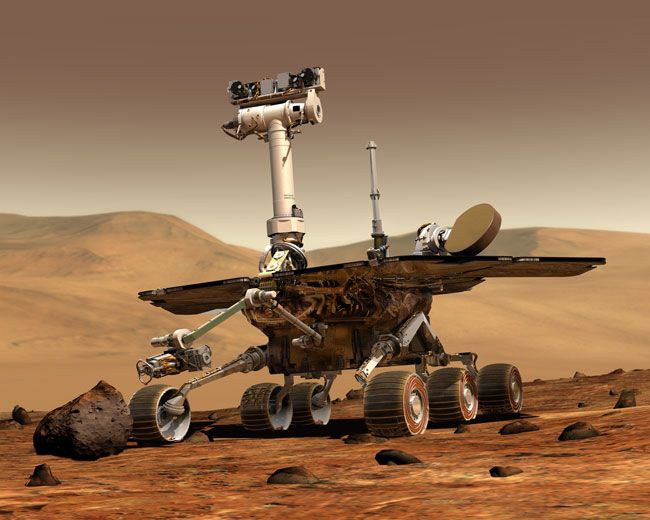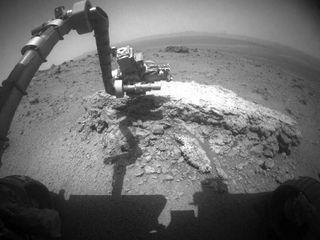
While people on Earth have just finished celebrating the arrival of a new year, two NASA robots a world away are marking a big milestone of their own: eight years on the surface of Mars.
The golf-cart-size Spirit rover landed on the Red Planet eight years ago today (Jan. 3). Its twin, Opportunity, touched down three weeks later, on Jan. 25, 2004. The two robots were originally supposed to spend 90 days searching for signs of past water activity on Mars.
They found plenty of such evidence, dramatically reshaping scientists' understanding of the Red Planet and its history. And the rovers just kept chugging along, continuing to make observations years after their warranties expired. NASA declared Spirit dead just last year, and Opportunity is still going strong.
Between them, the twin robots have covered 26.15 miles (42.08 kilometers) on the Martian surface to date, with Opportunity racking up the lion's share (21.35 miles, or 34.36 km).
"I seriously thought both Spirit and Opportunity would be finished by the summer of 2004," said Ray Arvidson, the rover mission's deputy principal investigator at Washington University in St. Louis. "I am totally blown away by the thought that we are still planning sequences for Opportunity today, and that we only lost Spirit because of her limited mobility and bad luck of breaking through crusty soil to get bogged down in loose sands." [Mars Photos by Spirit and Opportunity]

Following the water
Spirit and Opportunity touched down about 6,000 miles (9,656 km) apart, on opposite sides of the Red Planet. Both six-wheeled rovers found ample evidence that the Martian surface — now a frigid and bone-dry place — was warmer and wetter billions of years ago.
Sign up for the Live Science daily newsletter now
Get the world’s most fascinating discoveries delivered straight to your inbox.
Spirit's right front wheel stopped working in 2006, forcing the mission team to drive the rover backwards. The wonky, dragging wheel helped lead to one of the robot's biggest discoveries. One of the furrows it dug in the Martian dirt revealed subsurface deposits of pure silica, which forms when hot water reacts with rocks.
The rover thus uncovered strong evidence of a hydrothermal system on ancient Mars — an area perhaps similar to the United States' Yellowstone National Park, whose surging geysers and burbling mud pots are fueled by massive stores of underground heat.
The find was intriguing to astrobiologists, because it showed that at least some areas on Mars once had two key ingredients necessary to support life as we know it: liquid water and an energy source.
Opportunity, for its part, recently found clues that warm water may also have flowed or percolated on the rim of Mars' huge Endeavour Crater long ago.
The twin rovers will be remembered for these and other discoveries long after Opportunity's wheels have stopped turning. But the robots' otherworldly journey has likely made other contributions as well, researchers said.
"Certainly the science, and everything we've learned about the habitability of early Mars, is a big part of the legacy," said Steve Squyres of Cornell University, the twin rovers' principal investigator. "But I hope that another part of the legacy will be that the mission has been a source of inspiration for young people, encouraging them to pursue careers in science and engineering and technology."
Saying goodbye to Spirit
Spirit's bad wheel eventually helped lead to the rover's demise. With its mobility compromised, Spirit got mired in soft sand in May 2009. The trapped robot went silent in March 2010, after failing to maneuver into a position that would have slanted its solar panels toward the sun over the course of the 2009-2010 Martian winter.
The mission team finally pronounced Spirit dead in May 2011, pegging hypothermia as the likely cause. Extreme cold probably damaged the rover's electronics after it lost power during the harsh winter, researchers said.
Spirit is gone, but the rover — and its scientific contributions — are far from forgotten.
"Spirit had an excellent run, helping us understand without a doubt that early Mars had magmatic and volcanic activity that was 'wet,'" Arvidson told SPACE.com in an email. [Mars Explored: Landers and Rovers Since 1971 (Infographic)]
Opportunity keeps chugging along
After a three-year trek, Opportunity made it to the 14-mile-wide (22-km) Endeavour Crater in August 2011. The robot has spent the last few months poking around Endeavour's rim, where it recently uncovered what researchers say is the best evidence yet for liquid water on ancient Mars.
The Martian winter is setting in, and Opportunity has already found a nicely sloped outcrop where it can hunker down. But the rover won't go into hibernation; it will stay awake, studying the surrounding rocks and perhaps even moving a few feet now and then, researchers have said.
Over the next few months, the rover team also plans to track radio signals from Opportunity, using the robot's movement as a proxy for the rotation of Mars. Scientists can thus get very precise measurements of the planet's spin, which could reveal information about Mars' interior structure, Arvidson said.
Opportunity should be ready to rove again by June or July, researchers have said. While the robot is showing some signs of its advanced age, such as an arthritic shoulder joint in its robotic arm, there's no reason to think it won't hit the ground running.
"She's in excellent health," Bruce Banerdt, rover project scientist at NASA's Jet Propulsion Laboratory in Pasadena, Calif., said at a conference last month. "This is far from being a rickety old rover."
Opportunity will soon have some company on the Martian surface. NASA's 1-ton Curiosity rover is set to land on the Red Planet in August, on a mission to gauge whether Mars is, or ever was, capable of supporting microbial life.
This story was provided by SPACE.com, a sister site to LiveScience. You can follow SPACE.com senior writer Mike Wall on Twitter: @michaeldwall. Follow SPACE.com for the latest in space science and exploration news on Twitter @Spacedotcom and on Facebook.












